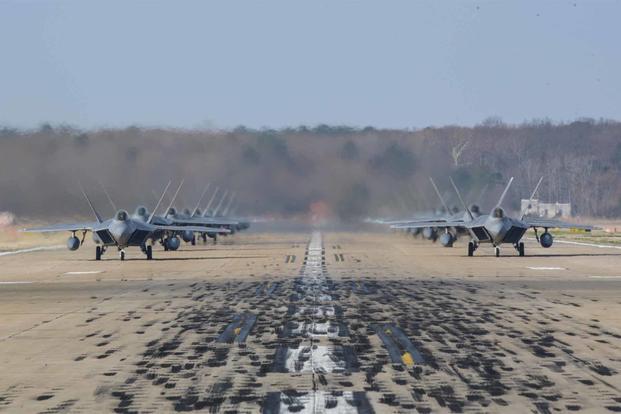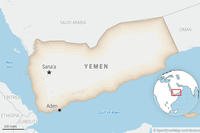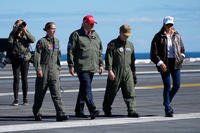The U.S. Air Force notified lawmakers that it has approved Joint Base Langley-Eustis, Virginia, to host its F-22 Raptor formal training unit, a move three years in the making. But don't expect to see more fifth-generation jets there just yet.
The service last week told Congress it had completed the necessary environmental analysis and signed a record of decision approving the base as its top pick to host the formal training unit, or FTU, Air Combat Command spokeswoman Alexi Worley told Military.com. Langley is already home to the 1st Fighter Wing, an F-22 combat unit.
The FTU is part of the 325th Fighter Wing and was originally housed at Tyndall Air Force Base, Florida. The unit was relocated to Eglin Air Force Base, roughly 60 miles from Tyndall in Florida's panhandle, after the base sustained heavy damage from Hurricane Michael in 2018.
Read Next: A Second Female Soldier Dies at Fort Bliss Within 7 Months
The decision "does not approve moving the 325 Fighter Wing to Langley, it approves Langley as the final location for the F-22 FTU mission," Worley said in an email. According to the environmental assessment, 28 F-22s and 16 T-38 Talons would eventually relocate to Langley.
The service is awaiting the completion of its "TacAir study," which will assess how future fighter concepts fit into the current mix of fourth- and fifth-generation fighters, before setting timelines for planned force structure moves related to the F-22, Worley added.
The Air Force must make key decisions about which aircraft, and how many, it wants to sustain long term. Air Force Chief of Staff Gen. Charles "CQ" Brown has said the service intends to go with a "four plus one" model as it downsizes from its current seven fighter or attack aircraft fleets.
During a panel discussion last month, Brown said the "four" are the F-35 Lightning II; F-16 Fighting Falcon; the F-15EX Eagle II, which entered the service's inventory in the spring; and the Next Generation Air Dominance, or NGAD, program, which defies the traditional categorization of a single platform, featuring a network potentially including an advanced fighter aircraft alongside sensors, weapons or drones. The venerable A-10 Warthog remains as the "plus one."
Noticeably absent from Brown's list were the F-22 stealth fighter and F-15E Strike Eagle, hinting that their retirements are on the horizon. When the F-22 retires will be decided by how quickly NGAD can be fielded, said Lt. Gen. S. Clinton Hinote, the Air Force's deputy chief of staff for strategy, integration and requirements.
If the service can secure enough funding for the NGAD in the fiscal 2022 and future budgets, and subsequently prove the technology prior to 2030, F-22s will start heading to the aircraft boneyard, he said in an interview with Military.com last month.
"All those things are interrelated," he said.
The Air Force has struggled with its F-22 fleet. While the F-22 is the dominant air superiority platform in the service's inventory, officials have admitted there are shortfalls, especially in maintenance.
The jet "has some limitations to it that you just can't modernize your way out of," Hinote said.
The program also has seen rising costs: The unit cost for the F-22 was around $150 million in 2009, but some estimates put the per-plane cost at closer to $250 million in current dollars.
The Raptor fleet also saw a reshuffling following Hurricane Michael. After the storm damaged most structures at Tyndall as well as dozens of stealth jets, the Air Force moved its remaining F-22 fleet, dividing the aircraft between Langley-Eustis; Joint Base Elmendorf-Richardson, Alaska; and Joint Base Pearl Harbor-Hickam, Hawaii.
In 2018, the Government Accountability Office issued a study that found that the Air Force was not utilizing the F-22 to the fighter's full potential due to maintenance challenges, inadequate opportunities for pilot training, and an inefficient organizational structure for the fleet.
The service, which last conducted an F-22 organizational review in 2010, chose to divide the fleet into smaller units, with "18 or 21 primary mission aircraft per squadron and one or two squadrons per wing," according to the report. Fewer jets per unit meant there is an imbalance of personnel and resources when units deploy, the GAO found.
The Defense Department announced in 2009 that it would cap its F-22 inventory at 187, taking delivery of the last aircraft in 2012.
The Air Force currently has 186 of the stealth fighters.
-- Oriana Pawlyk can be reached at oriana.pawlyk@military.com. Follow her on Twitter at @Oriana0214.
Related: Air Force Could Ditch Oldest F-35 Jets as Part of Fighter Downsizing, General Says












